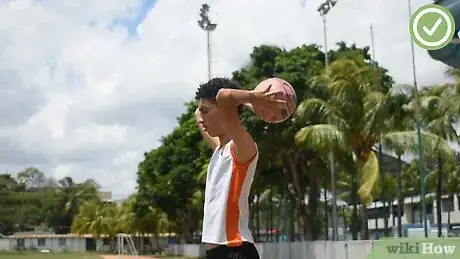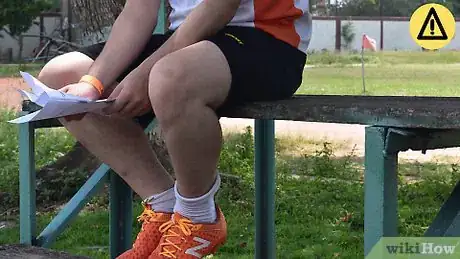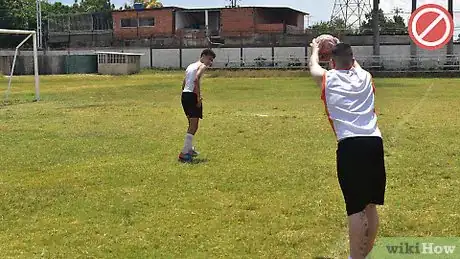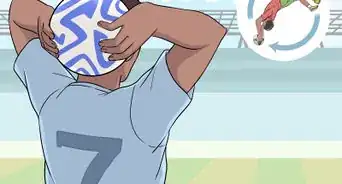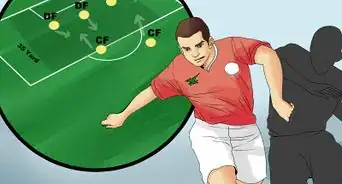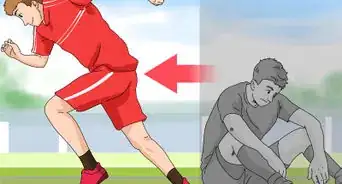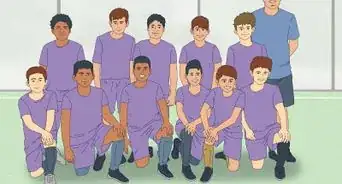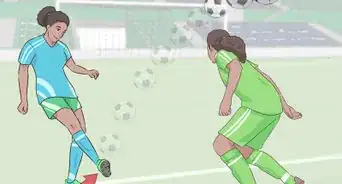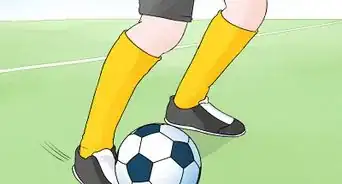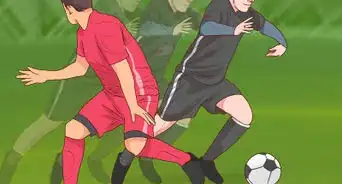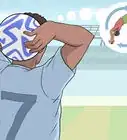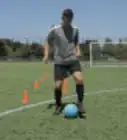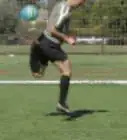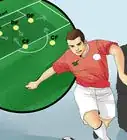This article was co-authored by Bernat Franquesa. Bernat Franquesa is the Co-Founder and Head of Methodology at APFC (Albert Puig Football Concepts), a youth development program for players and coaches with headquarters in San Diego, California. APFC provides soccer training for youth and educational content and consulting services for coaches, academies, and clubs. At APFC, Bernat is responsible for co-developing and applying technical guidelines for player development programs. He has been coaching soccer in Catalunya and the US since he was 15 years old.
wikiHow marks an article as reader-approved once it receives enough positive feedback. In this case, several readers have written to tell us that this article was helpful to them, earning it our reader-approved status.
This article has been viewed 360,825 times.
Throw-ins are small but crucial moments in a soccer game: they present an opportunity to maintain possession of the ball, capitalize on a turnover or - unfortunately - lose possession of the ball yourself. As such, the throw-in is one of the most fundamental skills in soccer. Add to this the fact that many players ignore the development of throw-in skills, and you've got a recipe for disaster. Don't fret, though. Follow these steps, and with a little practice, you'll be able to take advantage of throw-ins like the pros.
Steps
Doing a Normal Throw-in
-
1Pick up the ball with both hands, one on each side of the ball. Your hands should be roughly evenly spaced -- if the ball was a clock, your right hand would be at 3:00 and your left at 9:00. It can help to shift them back a bit, too, so your thumbs are almost touching in the back of the ball. This helps you get a bit more leverage on the throw.
- Throw-ins only occur when the whole ball completely passes over one of the touchlines. The restart occurs at the point it exited the field of play.
-
2Place your feet where the ball exited the field of play into touch. The rules of the game allow part of either foot to be inside the field of play, as long as a portion of the foot is actually on the touchline or behind the touchline. It is a myth that a thrower cannot stand on the touchline.[1]
- If you want to try a running throw, stand a few feet behind the sideline so that you can run up to the line without completely crossing it. Some players like to keep their feet together, while others put one foot in front and drag their back foot forward as they throw.
Advertisement -
3Arch your back slightly. Many players try to throw exclusively with their arms, but most of the power should come from your back and shoulders, as well as the momentum from your running start. Think of your body like a catapult being pulled back -- your feet are still firmly planted, but your spine becomes a loaded spring. Do this right before you're ready to actually throw the ball.
- For now, just work on arching as much as is comfortable. Work on getting proper form first, then throwing the ball further later. A light bend is enough to start learning with.
-
4Bring the ball up and over your head. Start with the ball behind your head and throw it over the top of your head. A legal throw in must travel "from behind and over his [or her] head." Referees might be a touch lenient here for a quick throw, but you must, at least, start with the ball held above your head.
- You will likely get called for an infraction if you start a throw from your forehead, or further forward. This can happen accidentally on quick throws.
-
5Release the ball with a forward flick of the wrists. Bring your arms up and forward so that your hands and the ball travel directly over your head. At the same time, bring your arched back forward like a spring and (if performing a running throw) drag the toe of your back foot on the ground. Extend your arms fully and release the ball from just behind the head.
- Remember to keep your head up and facing straight after the ball is released so you don't just throw the ball to the ground.
- Your release point depends on how far the throw needs to go. For big throws, let go as you pass over your head. For shorter passes, hold onto the ball until you cross your forehead or so.
- You cannot throw the ball with one hand like a keeper.
-
6Run onto the field to re-enter play, but don't touch the ball until one other player has. You cannot touch your own throw-in until another player (on either team) has touched it. So get back out there to help move the ball into scoring position.
- If you accidentally threw the ball to your opponent, (who by law must be at least 2 meters back from point of throw ), make up for it by running out to try to steal the ball back. If you deliberately do it make sure it is not in a violent or dangerous manner. You can play the ball off an unsuspecting opponent on a legal throw in.
- Always follow up your throw by getting back in the game and back in position.
-
7Review the rules to ensure perfect, legal throw-ins.[2] The rules for throws are not super difficult, but you should be mindful of them with every throw. Even the pros sometimes make a mistake, but it is no less embarrassing when you do it in a game. A legal throw-in must have all of the following elements:
- You are facing the field of play
- Both of your feet must be on or behind the touch line. As long as part of each foot is on some part of the 5 inch touchline or behind it and touching the ground at the moment the ball is thrown, the foot position is legal.
- You use two hands
- The ball comes from behind and over your head.
- You cannot score directly off a throw-in.
Taking Better Throw-Ins
-
1Work quickly. Throw-ins are rarely great offensive opportunities, and this is by design. Aim to throw the ball then quickly get back into the game.
-
2Aim for your teammates feet whenever possible. The easier you can make it for your teammate to control the ball and start moving, the better for everyone. Try to land the ball near their feet so that they can treat it just like a pass. Note, however, that there are times when your aim needs to change up a bit:
- If you communicate well, a throw to your teammates head, allowing them to flick it on, is a great way to get two quick passes in and scramble the defense.
- If there is a lot of traffic, and you're worried about getting picked off, aim for the chest. Your teammate can use their body to control and shield the ball, and it is a much bigger target to hit.[3]
-
3Put some power on your throws, treating them like passes. Don't just float the ball in. This gives the defense plenty of time to react and pressure the ball, which generally means your teammate is under attack before the ball even gets there. Put a little "oomph" on your throws, really dialing them in like passes. While you don't want to chuck it at a teammate, you don't want to lob it in, either.
- If you're flexible and comfortable with a front handspring, try out a powerful flip throw.[4]
-
4Scan the field for players on the move. Deciding where to deliver the ball is the most important step. You may have set plays for this or you may just need to find an open player. Once you've made your decision, you'll need to execute quickly so that your opponent can't detect where you're going to throw.
- It is always best to hit a teammate on the run instead of standing still. Movement makes the defense react -- standing still makes their lives easy.
-
5Use a running throw for added distance. Get a short running start--just 2-4 steps--to help you gain the needed momentum to power the ball to its target. Plant whatever foot is comfortable behind the line as you start your throw. Your back foot, which still has momentum, drags on the ground behind you to ensure you still keep both feet down.
- Your strong leg should be forward which is the opposite of how it would be if you were throwing a baseball.
- In general, anything longer than 2-3 steps doesn't add much more power to the throw.
-
6Throw the ball down the line towards you opponents goal when in doubt. If you've got no options, your team isn't moving, and the referee is telling you to "hurry it up," chuck it down the line towards your opponents goal. This leaves the defense few simple options to handle the ball, and the most likely result will be another throw in further down the field.
- Tell your teammates, if possible, to sprint down the line as you're throwing. If you can pressure the defense quickly off the ball you have a better chance of forcing an error.
-
7Never throw the ball in directly in front of you, or "square" to the field. Never throw the ball straight ahead, unless there are no defenders or pressure (like deep in your own defensive half). Think about it -- a throw-in is a high, slow, and predictable pass, one that is easily read and picked off. Furthermore, your teammate will receive the ball facing the worst possible direction -- the sideline.[5]
- The chances of an error or, even worst, getting picked off, are compounded by the fact that the defense running after the ball is heading right towards your goal.
Community Q&A
-
QuestionHow can I dive for me to earn a free kick?
 Community AnswerYou don't - that's called simulation and if the referee suspects you are diving, you may receive a yellow card as it is considered unsporting behaviour.
Community AnswerYou don't - that's called simulation and if the referee suspects you are diving, you may receive a yellow card as it is considered unsporting behaviour. -
QuestionCan I slide my back foot?
 Community AnswerYes, but make sure to keep it in contact with the ground because if your foot comes up, then the other team gets the throw instead. Some people prefer to slide a foot because it encourages a running start, while others think it gives away where they will throw.
Community AnswerYes, but make sure to keep it in contact with the ground because if your foot comes up, then the other team gets the throw instead. Some people prefer to slide a foot because it encourages a running start, while others think it gives away where they will throw. -
QuestionHow best can I do to throw-in a ball to my keeper in my own half?
 Community AnswerIt is dangerous to throw in a ball to your goalie because he cannot pick it up, so it is never the safe option. Only do it if there is no one of the opposition nearby.
Community AnswerIt is dangerous to throw in a ball to your goalie because he cannot pick it up, so it is never the safe option. Only do it if there is no one of the opposition nearby.
Warnings
- A throw-in will be awarded to the opposing team if the thrower performs the throw in incorrectly.⧼thumbs_response⧽
- A free kick will be awarded to your opponent if you throw the ball in and touch it before another player touches it.⧼thumbs_response⧽
References
- ↑ http://www.thefa.com/football-rules-governance/lawsandrules/laws/football-11-11/law-15---the-throw-in
- ↑ Bernat Franquesa. Licensed Soccer Coach & Head of Methodology at APFC. Expert Interview. 3 March 2020.
- ↑ http://www.soccer-training-info.com/how_to_do_flip_throw_in.asp
- ↑ http://www.active.com/soccer/articles/the-art-of-the-flip-throw
- ↑ http://athletics.ithaca.edu/coaches.aspx?rc=999&path=msoccer
About This Article
To do a throw-in in soccer, first pick up the ball with one hand on each side. Then, place your feet on the line where the ball exited the field, and arch your back. Then, start with the ball behind your head and throw it over the top. Next, extend your arms fully, straighten your back, and release the ball with a forward flick of your wrists. Finally, run back onto the field, but do not touch the ball until another player has. For more tips, including how to put more power into your throws, read on!
